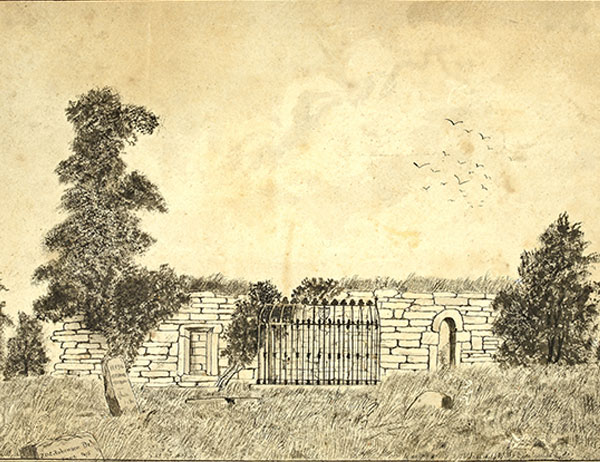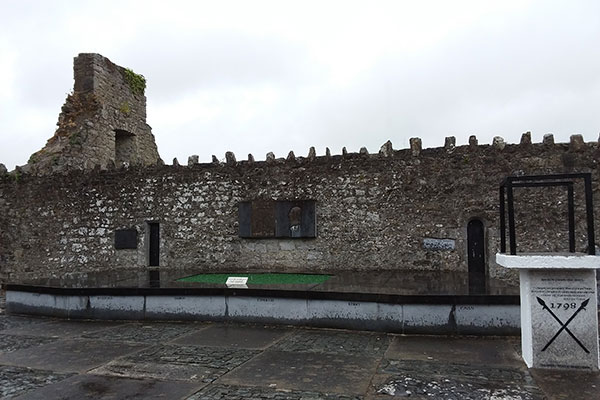Time to decommission ‘Wolfe’ Tone at Bodenstown?
Published in Issue 5 (September/October 2018), Platform, Volume 26By Sylvie Kleinman
This year marks the 220th anniversary of the United Irishmen’s proclamation of a sovereign and democratic Ireland, which so inspired the 1916 generation but was almost totally overlooked in 2016. Unlike Fitzgerald and Emmet, Theobald Wolfe Tone’s final resting place was both known and publicly accessible. The authorities released the traitor’s body to his family, knowing that he would be interred in their plot at Bodenstown far from the Dublin crowd. In his forthcoming book, Bodenstown revisited (Four Courts, autumn 2018), a compelling history of the successive gravestones and commemorations (with which this writer has assisted), C.J. Woods tactfully asks what precisely these pilgrimages had to do with Tone himself. A seminal moment in the ritualised adulation of the father of Irish republicanism would be Pearse’s 1913 oration, proclaiming Bodenstown the holiest place in Ireland, but later generations aligned ‘Wolfe’ Tone with the political conflicts of their times; his name became firmly identified with militant republicanism, and his Anglophobic pronouncements were recycled out of context. Partisan appropriations and constructs taint his name less now, yet he remains, literally, trapped in a timewarp. Planning permission has just been granted for a new, 1,400-plot cemetery close to the old churchyard, with extra car parking; archaeological issues will be addressed, but what will the impact be on the Tone memorial area? More pertinently, as we head towards 2022, how appropriate is the commemorative space installed in 1971?
A call for an annual Tone commemoration was voiced in Paris in October 1799, by which time both secularisation and revolution had led to new rituals heroising the common soldier fallen for the common good. Championing the cause of the widow of ‘Wolf-Ton’ [sic], it had paradoxically been Lucien Bonaparte who predicted that a monument would be raised by an independent Ireland in Dublin where his scaffold had once stood, where an annual festival of ‘Union’ would be celebrated in honour of this martyr de la liberté. Even in a churchyard, the Frenchman had probably imagined a memorial as a short obelisk with neo-classical features surrounded by verdant borders, symbolic of eternity and regeneration. An epitaph with the patriot’s name and dates would feature an emblematic quotation from his trial speech, very possibly about having done everything in his power to raise three million of his countrymen to the rank of citizen. Harmony and evergreen would inspire future generations to reflect on the transition from the mundane to the eternal life, with a potent dose of melancholy. No one, however, would have wished him to be severed from his immediate and extended family, also buried there, including an infant son, Richard (died c. 1787). Woods is confident that Matthew Tone’s remains had been released after his execution on 29 September 1798, and not cruelly disposed of in the vicinity of the Royal Barracks, according to folkloric memory. My own scrutiny of the parish registers of St Mary’s in Dublin revealed that Theobald was not the firstborn of Peter and Mary Tone. A William Tone was baptised there in March 1762, c. fourteen months before he was, and evidently died in infancy; so too would brothers Peter (b. 1769) and Francis (b. 1772). It is very safe to assume that all the Tone sepulchres were in a family vault, or graves gathered close together. The church was already in ruins and covered with ivy in 1798, and the simple grave, later shielded from chipping by souvenir-seeking pilgrims within a metal cage, forms the backdrop of numerous photographs of pilgrimages and speech-makers. Presumably owing to financial hardship and the fraught political context, the only documented gravestone (until Tone’s in the 1840s) was for his grandfather, William (d. 1766).
On 31 October 1969 a UVF bomb damaged the Tone memorial stones; Woods concludes from press reports that the damage was far from extensive. The National Graves Association swiftly promised to repair the memorials, publishing appeals for donations; then there was talk of ‘an even more worthy memorial’. The grave was not to be restored but the site flattened and built upon. On 15 February 1971, the Irish Times reported that the new grave and memorial would be ‘much more impressive’; translation: the ‘Tone’ area would be spread over a much wider surface, the arena we see today, precisely 50ft by 30ft, according to the pre-metric Leinster Leader (1 May 1971). Was concrete poured over any Tone family graves, or others departed from the locality? But weep not for ‘Wolfe’ Tone, for he was rebaptised into his new republican family. On the church wall overlooking the ‘grave’ is a bronze relief portraying Tone in profile and a quotation from Pearse. It is today the least unattractive part of the 1970s arrangement; Tone is congenial, instantly recognisable and neither prettified nor neutralised of any humanity like ‘Tonehenge’. By introducing the words of others into the core feature of the overall design, however, we have now transitioned from a memorial to Tone to a political construct of ‘Wolfe’ Tone. The ‘grave’ is a space sunken into a raised platform 3ft high filled with green glass fragments (the green fields of Ireland, perhaps?). A sign urges the faithful not to sit on it, but the web provides images of weary pilgrims nonchalantly availing of its ample seating space. Square stone plaques with short, selective, partisan and easy-to-process quotes are embedded into tiered concrete leading up to the ‘grave’. The choice of Pearse’s ‘holiest place’ was pertinent; he himself is hardly to blame, even if posterity is. His oration eloquently embodies the mind-set of his generation, and brilliantly fulfilled its mission—to stir to action by appealing to emotion. But Pearse also alluded to the thought of Tone’s children ‘plucking at his heart’ as he lay dying in his cell; he was touched by his character, later neutralised. Another plaque references Liam Mellows, ‘… in the name of Tone … of Pearse … of Ireland Fight on’, embedding a bellicose (and anti-Treaty) layer of ahistorical misappropriation. A third plaque features a phrase from Tone’s diary plucked out of context, the iconic ‘men of no property’, useful to the class-oriented rhetoric of later generations. No matter that Tone had outlined to the French that only a tiny élite minority owned most of the land in Ireland, making the vast majority of Irishmen in 1796 unpropertied. At the base of flagpoles are plaques to Mellows and his three comrades executed in 1922, and to SAOIRSE and the four provinces. A second quote from ‘Wolfe’ Tone’s trial speech, framed by two crossed pikes, adorns the front of a concrete speaker’s rostrum. I HAVE REGARDED THE CONNECTION BETWEEN ENGLAND AND IRELAND AS THE CURSE OF THE IRISH NATION. He had also declared that he had been ready for ‘fair and open war’, but sincerely lamented that 1798 had ‘degenerated into a system of assassination and massacre’. How prophetic it would have been, in 1971, to inscribe those words of Tone’s in stone.

Above: Bodenstown church was already in ruins and covered with ivy in 1798. Tone’s simple grave was later shielded from chipping by souvenir-seeking pilgrims within a metal cage. (NLI)

Above: ‘Tonehenge’—the grave site as it appears today. (Sylvie Kleinman)
The ‘grave’ is certainly very well maintained, but can we not depoliticise Bodenstown? The current monument is also stark, bleak, outdated, even unintentionally brutalist; would it get planning permission today? By all means discuss and debate, but do not dictate for Tone what his stance may have been in 1922. Should the people of Kildare not be consulted on a suitable but truly national design? Should we not restore the memory of Tone’s family in a dignified garden-cemetery arrangement, and leave the twentieth century behind?
Sylvie Kleinman has just published ‘Matty and the Daffs: the family life of Theobald Wolfe Tone in exile, 1795–1798’, in M. Hatfield, J. Kruse & R. Nic Congáil (eds), Historical perspectives on parenthood and childhood in Ireland (Arlen House, 2018).
















